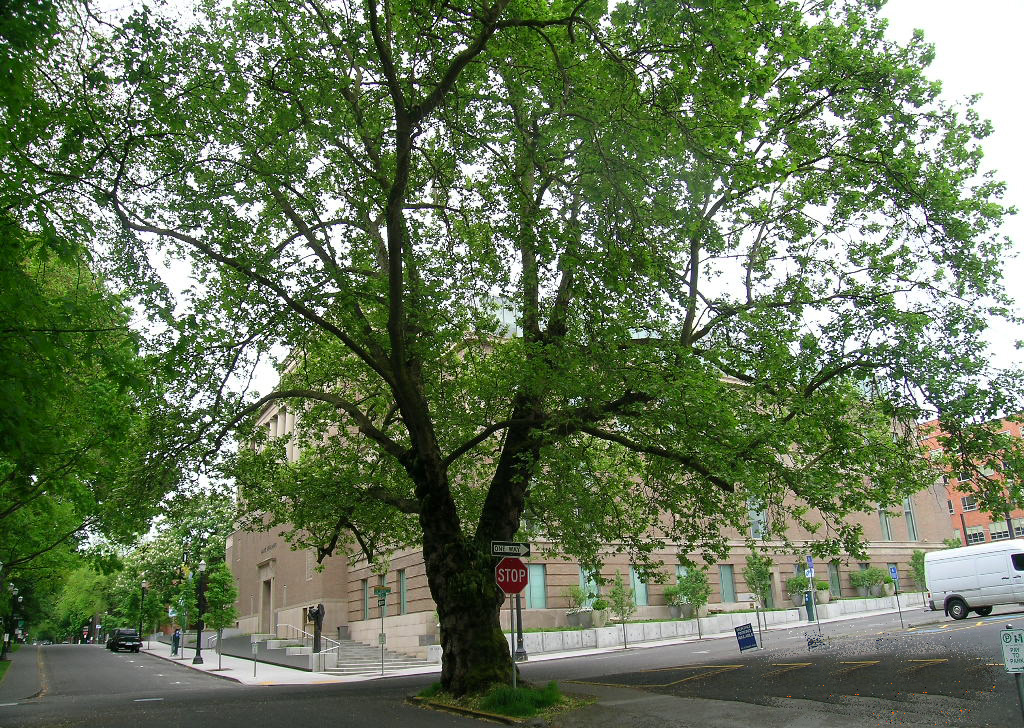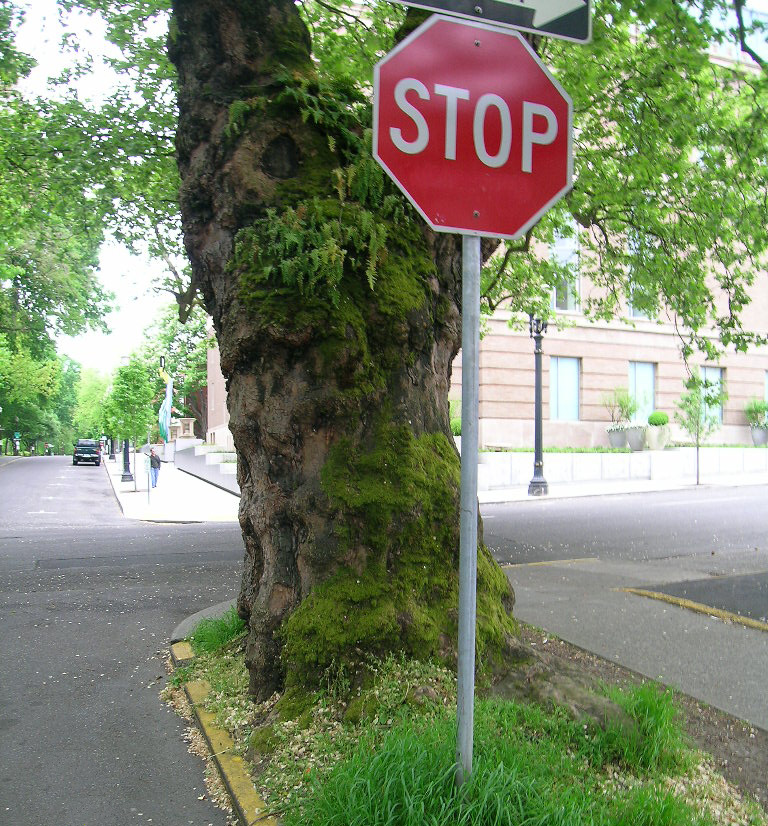London Plane: Friend or Foe?
Platanus x acerifolia

There is no tougher tree than the London Plane. It is easy to transplant, grows fast in almost any soil, and can tolerate more root impact than any other tree species. The London Plane can develop massive trunks with spreading crowns, and live for centuries. But its success has been part of its demise. Its roots are so tough and aggressive, that it can lift sidewalks and curbs, invade sewer pipes, and crack building foundations. But whose fault is that, the tree's or the people who planted them there?
The London Plane has been a popular urban tree for quite some time, and was almost over planted. People mistake it for the Sycamore, quite honestly because it looks like a Sycamore. I will omit a detailed description since all arborist should recognize this tree. My purpose here is to discuss its use and also its misuse.
Existing trees planted years ago in tight locations are cursed today for their size and power. The alternatives available for these mature trees are to cut them down and replace, ramp over the lift they have created, or just learn to live with it. In many cases, we can prune roots and replace walks to buy at least a few more years. They are known to have exceptional root pruning tolerance. Or better yet, you can give them more room by expanding the space.
Future planting may be in question, though, as some communities have actually outlawed the planting of London Planes. This is unfortunate because London Plane trees in the right place are outstanding urban trees for all of the qualities mentioned above.
The challenge is planting them where they have enough space to grow. Planting spaces should be at least 8' to 10' in width, and include a root barrier along the edge of the sidewalk and curb. Don’t forget about above ground space for a very large and fast growing crown. Their trunks can become huge, gnarly, grotesque or picturesque, irregular, even beautiful over time. The crown will be taller than wide but eventually very large also. So give this tree room to grow.

Cankerstain is said to be serious, but I suspect it to be a bigger problem in the east. Anthracnose is a constant nuisance in the PNW, but seldom deadly. Selected varieties like ‘Bloodgood’, ‘Columbia’, ’Liberty’ and others are resistant to Anthracnose, so always ask for these when planting. Apparently, some people are allergic to the tiny hairs or sawdust from these trees, so do not be surprised if that reason is used to have a Plane tree removed. As available space is reduced in our urban areas, there will be an even greater call for smaller, shorter, and narrower trees all over town. When a great amount of space is available, large maturing trees, such as London Plane cultivars, should be considered. Take advantage when you get a big space to plant, and use it when you want a big tree fast. Remember to always pick the right tree for the right place.
As always, e-mail me additional comments on this tree.
Platanus x acerifolia

There is no tougher tree than the London Plane. It is easy to transplant, grows fast in almost any soil, and can tolerate more root impact than any other tree species. The London Plane can develop massive trunks with spreading crowns, and live for centuries. But its success has been part of its demise. Its roots are so tough and aggressive, that it can lift sidewalks and curbs, invade sewer pipes, and crack building foundations. But whose fault is that, the tree's or the people who planted them there?
The London Plane has been a popular urban tree for quite some time, and was almost over planted. People mistake it for the Sycamore, quite honestly because it looks like a Sycamore. I will omit a detailed description since all arborist should recognize this tree. My purpose here is to discuss its use and also its misuse.
Existing trees planted years ago in tight locations are cursed today for their size and power. The alternatives available for these mature trees are to cut them down and replace, ramp over the lift they have created, or just learn to live with it. In many cases, we can prune roots and replace walks to buy at least a few more years. They are known to have exceptional root pruning tolerance. Or better yet, you can give them more room by expanding the space.
Future planting may be in question, though, as some communities have actually outlawed the planting of London Planes. This is unfortunate because London Plane trees in the right place are outstanding urban trees for all of the qualities mentioned above.
The challenge is planting them where they have enough space to grow. Planting spaces should be at least 8' to 10' in width, and include a root barrier along the edge of the sidewalk and curb. Don’t forget about above ground space for a very large and fast growing crown. Their trunks can become huge, gnarly, grotesque or picturesque, irregular, even beautiful over time. The crown will be taller than wide but eventually very large also. So give this tree room to grow.

Cankerstain is said to be serious, but I suspect it to be a bigger problem in the east. Anthracnose is a constant nuisance in the PNW, but seldom deadly. Selected varieties like ‘Bloodgood’, ‘Columbia’, ’Liberty’ and others are resistant to Anthracnose, so always ask for these when planting. Apparently, some people are allergic to the tiny hairs or sawdust from these trees, so do not be surprised if that reason is used to have a Plane tree removed. As available space is reduced in our urban areas, there will be an even greater call for smaller, shorter, and narrower trees all over town. When a great amount of space is available, large maturing trees, such as London Plane cultivars, should be considered. Take advantage when you get a big space to plant, and use it when you want a big tree fast. Remember to always pick the right tree for the right place.
As always, e-mail me additional comments on this tree.
Jim Barborinas
ISA Certified Arborist #0135
ASCA Registered Consulting Arborist #356 CLICK HERE FOR MORE TREE PROFILES
Certified Tree Risk Assessor #PNW-0327
ISA Certified Arborist #0135
ASCA Registered Consulting Arborist #356 CLICK HERE FOR MORE TREE PROFILES
Certified Tree Risk Assessor #PNW-0327
15119 McLean Road
Mount Vernon, WA 98273
(O) 360-428-5810
(M) 360-770-9921
(F) 360-428-1822
[email protected]
Mount Vernon, WA 98273
(O) 360-428-5810
(M) 360-770-9921
(F) 360-428-1822
[email protected]


